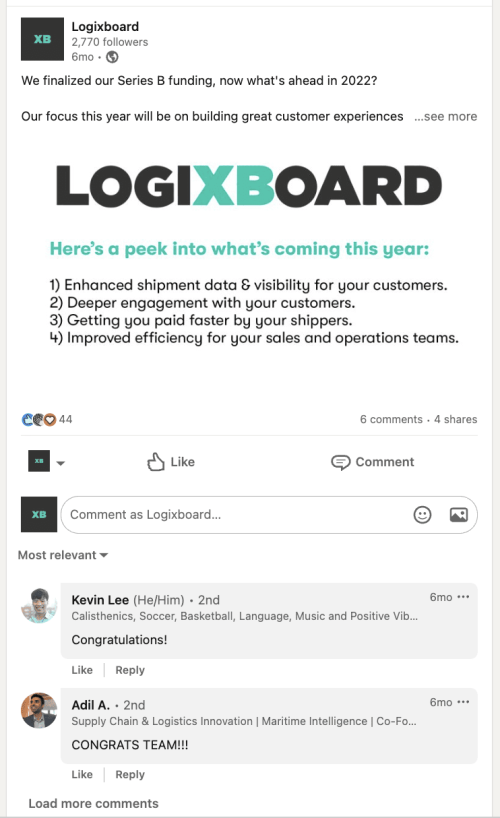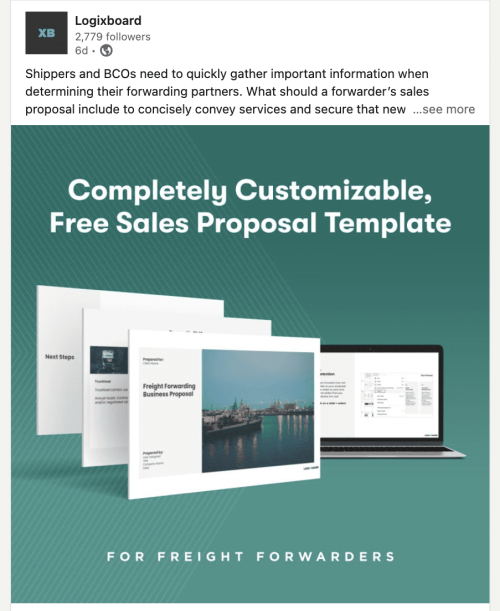In this article
Freight forwarding has always been about communication, customer service, relationships, and people. Social media offers another way for forwarders to communicate and connect, but with over 106k freight forwarding brokerages and agencies in the US in 2022 and a little more than 41k “Logistics/Supply Chain” and “Package/Freight Delivery” US businesses active on LinkedIn, it is clear there is plenty more opportunity for freight forwarders to be seen and heard on social media by customers and prospects alike.
Fortunately it doesn’t take a dedicated team, lots of time, or an in-depth marketing plan to start making an impact through your social media accounts.
In this overview of how to start forming your voice on social media as a freight forwarder we’ll cover:
- The Power of a Social Presence in Logistics
- Defining Goals and Desired Outcomes
- Finding Your Voice
- Next Steps
By investing a little time into establishing your forwarding company’s voice on social media, you can use those platforms to build and strengthen your relationship with shippers, expand your network and land more clients.
The Power of a Social Presence in Logistics:
Strengthen Customer Experience:
Use your social media accounts to strengthen your customer experience by treating your platforms as another place to directly communicate with your customers. Make sure to follow your customers on the platforms they have a presence on (maybe even incorporate it into your onboarding process with new shippers to guarantee it is done) and invite customers to follow your company page to stay up to date.
This will give you the chance to interact more with your customers. Whether they have questions that pop into their minds while they are looking at industry-related posts on LinkedIn, they go to your company’s Facebook page to see your latest visibility platform updates, or they are just interested in hearing more about your team members from your company spotlight posts, social media gives your customer experience a deeper level of connection. It gives your team a chance to answer, connect, and share materials with customers on platforms they may find more attractive to use than standard emails.
Win New Business:
With 3.6 billion people using social media in 2020 (and the projected climb of that number), your presence on social media as a freight forwarder can be used to build more authority with your prospects and brand awareness with unknown potential customers.
Social media gives your customers a place to publicly share positive testimonials and a platform for your team to get in front of qualified leads with updates that may encourage them to want to learn more about your company. With so many forwarding options for shippers, social media can be another touchpoint with prospects to reinforce why your company is the right choice (or at least open the door to more direct conversations).
Make sure to encourage your team to have a social media presence (primarily LinkedIn) and to actively engage with the company page. The sales team and account managers can directly engage with prospects and customers, while also being part of larger industry conversations to increase their industry authority.
Build Relationships:
The logistics industry is not built off mere data, but also the communication and relationships that enable different stages of an order’s journey to be successful. Whether it is forwarding consultants, software consultants, software companies, carriers, industry news sources, or forwarding alliances/organizations, many can be found on social media (even if only on LinkedIn). Building your own presence, consistent posting schedules, and dialogue with others in the industry can help develop lucrative partnerships.
Defining Goals and Desired Outcomes:
Social media can be used, and the resulting performance evaluated, in various ways. It is important to decide what your desired outcomes from investing time in establishing your presence on these platforms are before you blindly start posting. Take a peek at the top three goals for B2B service-based companies when using social media.
Brand Awareness & Engagement
If your social media is being created to focus on awareness level marketing and to build up connections to industry professionals/customers, brand awareness and engagement-based goals should shape your strategy. High engagement posts, page followers, individual post activity, and social media growth specific KPIs should be monitored – then successful strategies can be acted on more repeatedly.
Lead Generation & Customer Acquisition
If social media is only being invested in (time and money) to see direct results in capturing new leads or prospects, lead generation-based goals should shape your strategy. Your goals should be based on hard numbers and data related to KPIs that go farther than the previous engagement goals. You should be using links to track who is directly coming from your social media and booking a call online, reaching out to sales personnel on social media, or reaching out through email to connect with your team.
Thought leadership
If your goal is to build authority in the logistics industry and stand out in your online presence as a go-to voice on recent happenings, thought leadership based goals should shape your strategy. Recent logistics news, new legislation, M&A, trending topics, and innovations in the industry should all be closely followed and acted on. Thought leadership is about staying up to date, creating valuable and unique insights on happenings, and really building a presence/name for yourself on a given platform.
Finding Your Voice:
When you decide what content you want to post, make sure you know the voice you want the company to have as you present it. With the copy and design of your posts on social media, try to establish a basic idea of how you want to come across.
Voices on social media will vary from company to company. Decide if you want to sound like a relatable friend, a source of authority, or even a lighthearted and funny industry friend. Try to look at the social media of companies you admire (does not have to be in the logistics industry) and then start to form your own voice from there.
Building out the personas of people you want to be engaging with for each post is also a strategic way to make sure your post is making an impact. If you know you want to be targeting a certain team in a prospect customer’s company (i.e. C-level executives) or just want a focus on a top-of-funnel logistics crowd, build out what those personas could look like. You should be able to use those personas to shape the language/design around posts targeted at different people.
Next Steps!
In part two of this blog series, we will be sharing our tips on using your social media voice to start creating your content strategy:
- Content Ideas
- Using Different Platforms
- Measuring Your Efforts
Check out “A Freight Forwarder’s Guide to Using Social Media Part 2 of 2: Making Your Content Strategy.“



